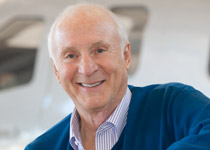
Between comments about my flat feet and a need for orthotic inserts in my shoes, my podiatrist, Dr. Jon Williams, began mumbling about his wanting to fly a Cessna 172 VFR into Los Angeles International Airport. “Why do you want to do that?” I asked.
“I’m a 300-hour private pilot and fly out of Santa Paula [a nontowered airport northwest of Los Angeles]. My radio skills aren’t what they could be, and I figure that if I could learn to get in and out of LAX without killing myself, that it would give me the confidence needed to get along elsewhere.”
“Interesting concept,” I said as I stuffed my aching feet into my shoes. “You’re not planning to do this on your own, are you?”
“No, I’m not,” he said. “That’s where you come in.”
I got the picture and agreed to ride shotgun for Jon’s introductory flight into one of the world’s busiest airports. First, though, we spent time reviewing detailed information about LAX listed in the Airport/Facility Directory. We also pored over a taxi diagram of the airport and reviewed critical airport signage and markings, of which there are absolutely none at his home airport.
We departed Santa Paula the next day. After clearing the traffic pattern, I suggested to him that we contact SoCal Approach Control as soon as practical and request flight following to Los Angeles. “It’s important,” I advised him, “to get into the system early in the flight so that ATC knows your intentions as you point the nose toward the beehive of Class B airspace.”
We were given a few simple clearances, a few vectors, and thankfully no holding before receiving permission to enter Class Bravo. Approaching the airport from the northeast, we were handed over to the tower and cleared to land on Runway 24R following a Boeing 737 on final. This was bad news and good news. The bad news was that landing on the north side of the airport would necessitate significant and complex taxiing to get to Atlantic Aviation on the south side of the airport. The good news was that this would throw Jon into the thick of things and give him the experience he wanted.
After landing on 24R, we were instructed to hold short of Runway 24L on the high-speed taxiway between the parallel runways. Holding short was a good thing. A Boeing 777 soon roared by and lifted off in front of us. The Cessna rocked somewhat in response, a nudging reminder that manmade tornadoes and hurricane-like winds threaten those who do not operate small airplanes cautiously at such airports.
Finally cleared to cross 24L, we were eventually southbound on Taxiway Sierra only to see that we were heading toward an opposite-direction Airbus A380, a perfect setup for a game of chicken that had only one possible winner. The Airbus turned sharply right and stopped at its gate, its jet blast cleaning our taxiway of dust. “How do we know when it is safe to taxi behind him?” Jon asked. “Just wait for his rotating beacon to be turned off,” I instructed. “This signals that his engines have been shut down. In the meantime, don’t look behind us. There’s a 747 following closely, very closely, waiting for us to proceed.”
After changing to the ground-control frequency for the airport’s south side and being cleared through a maze of taxiways and additional runways, we eventually arrived at Atlantic Aviation and parked amid the heavy iron populating the ramp. We were the only single-engine airplane there, and the only aircraft with a propeller. Don’t ask for avgas at LAX because there is none. The ramp fee can be as much as $100 for a single—but you do get free cookies and bottled water.
After returning to Santa Paula, Jon said that he benefitted greatly from the experience, but added that it had been stressful. He also felt that the LAX controllers had been impatient with his apparent lack of radio experience. “Don’t take it personally, Jon,” I consoled. “You’re just not accustomed to the frenetic pace of such an operation. Believe me, O’Hare and Kennedy can be much worse. You get used to it.”
Jon added that there was no way he could have prepared himself not to get rattled—an interesting comment from a combat veteran with three Purple Hearts.
Santa Paula and LAX are only 40 miles apart, yet worlds apart procedurally. The Hobbs meter recorded 2.0 hours that day, most of it spent on the ground.
The story of Jon’s adventure apparently has spread. Other pilots have called me about making the flight. I just hope that the patient controllers at Los Angeles will continue to endure these training trips.
Barry Schiff is a former TWA captain who lives in Southern California.
Web: www.barryschiff.com



